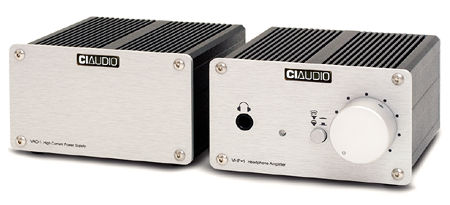| Columns Retired Columns & Blogs |
Channel Islands Audio VHP•1 headphone amplifier Page 2
This was no small improvement, but it wasn't the biggest change the VAC•1 wrought. That would be its increase in dynamic contrast. I don't mean that the VAC•1 allowed the VHP•1 to play any louder. It may have done, but that wasn't what had me mining my CD collection for lost gems. With the VAC•1 powering the amp, there was more contrast between music and silence: where there was music, it seemed as if there was more of the stuff it was made from; where there wasn't, there was more nothing.
Is that clear? No—but it wasn't clear to me at first, either. I initially thought about it in criticspeak, throwing around such terms as increased palpability, transcendent transparency, and layered immediacy. But that was just late-night listening-session twaddle.

Listening to Fritz Reiner and the Chicago Symphony's recording of Prokofiev's Lieutenant Kijé Suite (CD, RCA Living Stereo/JVM-XR24026) finally made the difference manifest: I was hearing Reiner's trademark precision with phenomenal clarity. All of the tiny accents, shadings, and dynamic and metric shifts were rendered with greater contrast. In other words, everything that made Reiner Reiner came across better.
And don't even ask about those big brass and low-string flourishes in The Burial of Kijé. That was emotional to the point of intimacy—and a gentleman never gossips.
Little known
The week of June 19, I accompanied John Atkinson to Sioux Falls, South Dakota, where he again recorded Cantus in the Washington Pavilion. As usual with these projects, JA set up several different pairs of microphones so he could blend their feeds together to achieve an artistically truer sonic perspective than any single pair of transducers could produce. Because even the editor of Stereophile has only two ears, this presents a minor problem for monitoring the microphone feeds at the sessions. John tends to listen to the two pairs of omnidirectional microphones, alternating between two different sets of headphones, while Cantus' music director, Erick Lichte, and I monitor the cardioid feed—Erick listening for artistic and performance issues, and I basically listening for anomalies.
Except this time out, at the beginning of Day 2 of recording, there I was, hunkered down with the VHP•1, the VAC•1, and a pair of Sennheiser HD-600s. Erick slated a take, and I heard a hum almost buried below the noise floor—a hum that was immediately buried by the sound of 11 men singing. I struggled and failed to hear the hum throughout the take, then couldn't hear it over the talk-back afterward. I signaled to Erick to quiet the stage; when he did, the hum was there, deep in the hall sound.
"How loud were you listening to hear that?" Erick said.
Not all that loud—but I had help. The VHP•1 and VAC•1, despite their relatively modest prices, were definitely studio quality. (By the way, the hum was caused by a cable with a bad solder connection, and it took a while to find—but we might have wasted a lot more time recording noisy takes if it hadn't been for the CIA products.)
Little difference
To put the performance of the VHP•1 and VAC•1 in perspective, I compared the $498 CIA combo with the $449 Musical Fidelity X-CanV3 I used to monitor 2004's Cantus recording sessions in Goshen, which resulted in Comfort and Joy: Volume One (CD, CTS-1204) and Volume Two (CTS-1205).
The X-CanV3 served me well in Goshen—and at home. It's no slouch when it comes to solid bottom-end recovery, and was just as impressive as the CIA stack in delivering the big tuttis of Lieutenant Kijé. Big sound, check; hall detail, check; dynamic contrast, check—in terms of the big picture, the MF and CIA were awfully close.
However (you knew there had to be a "however," didn't you?), they weren't identical. The VHP•1 had more upper-midrange bloom—or maybe I should say that the X-CanV3 sounded drier through the upper mids. Either way, this was especially apparent listening to the Chicago Symphony's superb string section.
The question is, which one was right? I think it might have been the X-CanV3, because the Sennheiser HD-600s do have a slightly de-richified upper-midrange balance, a quality that keeps many headphone users from completely falling in love with them. Does that mean I preferred the X-CanV3 to the VHP•1?
Yes. No. I don't know.
On one hand, I can't really approve of a deviation from absolute accuracy. It would be a bad career move—and it makes me squirm. On the other hand, the Sennheisers are my preferred headphones, and they sounded more right with the VHP•1. It's hard to argue with pleasure.
Either would make me happy. I think the Channel Islands combo makes me happier.
Little giant
At $349, the Channel Islands Audio VHP•1 is a heck of a good headphone amplifier. It's versatile and it's tiny, which means you can pretty much put it where you need it. It's also convenient, possessing an impedance switch and a unity-gain feed-through, both thoughtful features. By itself, it would have made my short list of must-audition headphone amps.
Add the VAC•1, however, and the VHP•1 rockets to the top of that short list. The increases in bottom-end extension and power—and, more important, dynamic contrast—make it a serious rival for the best of class in its price range—and maybe way above it.
- Log in or register to post comments




































